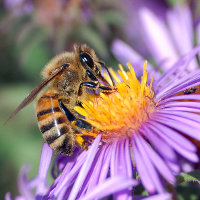A Focus on Goldenrods (Solidago sp.)
July 23rd, 2025 by Alex Zorach
When we launched our site and began prioritizing which plant articles and ID guides to complete, the initial focus was on trees, which made sense because trees are the largest plants in an ecosystem, there are relatively fewer tree species, and there were more sources writing about them.However, herbaceous plants (plants that do not grow woody parts) are also important to ecosystems, and there are some regions, such as the Great Plains, where they are more dominant than woody plants. And arguably one of the most important genera of herbaceous plants in north America is the goldenrods (Solidago sp.)
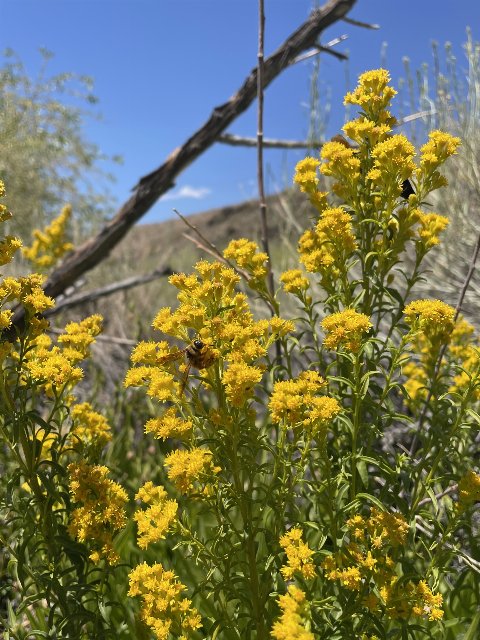 This patch of Nevada goldenrod (Solidago spectabilis) is growing at Inyo National Forest in California. Although best-known as species of grasslands such as meadows, prairies, and savannas, goldenrods occur in habitats as diverse as deserts, forests, and wetlands. This species prefers locally-wet sites such as seeps, springs, and streambanks in deserts, mountain valleys, and alkali flats. Photo © mel letterman, CC BY 4.0, Source.
This patch of Nevada goldenrod (Solidago spectabilis) is growing at Inyo National Forest in California. Although best-known as species of grasslands such as meadows, prairies, and savannas, goldenrods occur in habitats as diverse as deserts, forests, and wetlands. This species prefers locally-wet sites such as seeps, springs, and streambanks in deserts, mountain valleys, and alkali flats. Photo © mel letterman, CC BY 4.0, Source.Including hybrids, BONAP recognizes a whopping 100 species of goldenrod in North America, all of which are native. We currently list 77, as we have not yet listed all hybrids. There are even some species that have been split from BONAP's 2014 listing, so the final count may number higher than 100.
Lately we have begun the difficult task of building ID guides for the goldenrods of North America. There are several reasons we have chosen to prioritize these plants, and I hope this post can highlight both the goldenrods and our reasons for prioritizing them.
Goldenrods as Keystone Species
Goldenrods are often hailed as keystone species, meaning that they have disproportionately large effects on their environment relative to their abundance. The importance of goldenrods in their environment is not limited to any one factor, so we will explore several.High Biodiversity in North America
Although goldenrods are found on several continents, including Europe, Asia, South America, and a small region in northwest Africa, North America is the global center for goldenrod diversity; only 4 are found in South America and 6-10 in Europe, depending on how you classify them.The diversity among goldenrod species enables them to thrive in surprisingly different habitats. People mostly think of goldenrods occurring in disturbed, open, sunny habitats, but there are numerous species that are found in shade, and they have partitioned the niches even in these habitats. For example, in the east, zigzag goldenrod (Solidago flexicaulis) is found in moist, rich forests, often on north- or east-facing slopes. Blue-stemmed goldenrod (Solidago caesia) also occurs on woods and in slopes, but usually on drier sites, often with some clay and/or rock in the soil. Another woodland goldenrod, elmleaf goldenrod (Solidago ulmifolia), is usually found on dry uplands with calcareous soils.
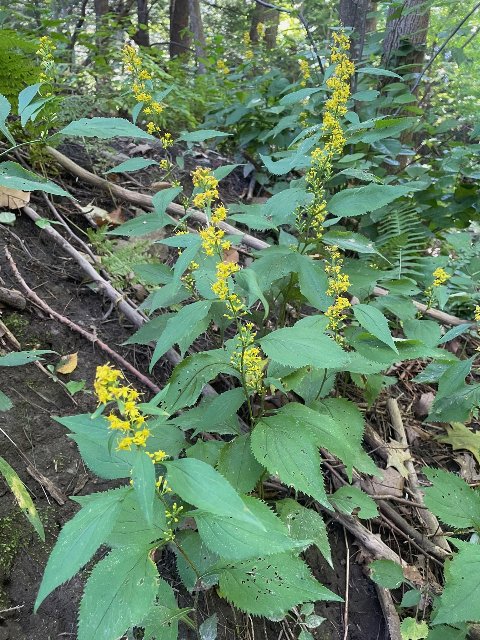 Zigzag goldenrod (Solidago flexicaulis) is often seen as atypical among goldenrods in that it grows in shade, typically in forests, and its inflorescence shape is also different, blooming out of the upper leaf axils, not just a "rod" shape at the top of the stem. But there are actually numerous goldenrods that grow in forests, as well as others that have this axillary bloom pattern. Photo © Tom Scavo, CC BY 4.0, Source.
Zigzag goldenrod (Solidago flexicaulis) is often seen as atypical among goldenrods in that it grows in shade, typically in forests, and its inflorescence shape is also different, blooming out of the upper leaf axils, not just a "rod" shape at the top of the stem. But there are actually numerous goldenrods that grow in forests, as well as others that have this axillary bloom pattern. Photo © Tom Scavo, CC BY 4.0, Source.Seaside goldenrod (Solidago sempervirens) has adapted itself to coastal sand dunes with their coarse sandy soils and salt spray. In the north, Bog goldenrod (Solidago uliginosa), as its name suggest, grows in bogs. In the southwest, Wright's goldenrod (Solidago wrightii) grows on dry hillsides and Juniper-Pinyon woods. And these are all what one might think of as "atypical" goldenrods. There is even a goldenrod that isn't yellow: white goldenrod (Solidago bicolor).
The species richness in goldenrods is directly related to their abundance and wide distribution in different habitats, which is in turn related to their support of insects, as insects tend to evolve to eat plants that are abundant.
Support for Insects
It is hard to write a section about how many insects goldenrods support, as there is so much to say. Goldenrods are best known for their showy flowers and support for pollinators. Their inflorescences are large, with long bloom periods in which new flowers open as others are pollinated. The nectar tubes tend to be short and accessible, with spots for larger insects to perch. So the flowers tend to attract small and large pollinators alike, both short-tongued and long-tonged bees, as well as wasps, flies, and lepidoptera (butterflies, skippers, and moths), as well as less-well-known pollinators such as beetles, ants, and even the occasional true bug. Each of these groupings of insects has numerous different species which visit goldenrod flowers, and in the cases of the bees, wasps, and flies, the list is quite long.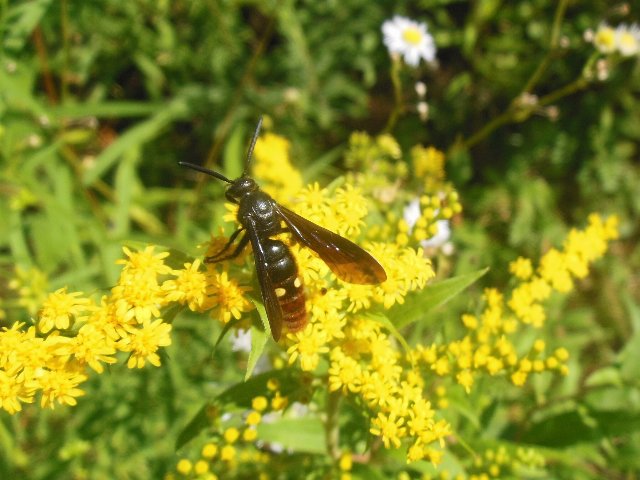 This photo shows a blue-winged scoliid wasp (Scolia dubia) feeding on Goldenrod. Adults of this wasp are attracted to goldenrod nectar, but in their larval form they eat beetle larvae. The presence of goldenrods thus exerts an indirect effect on controlling the populations of herbivorous beetles. Goldenrods belong to hundreds of such ecological relationships, which is one reason why they are considered keystone species. Photo © Christopher Volker, CC BY 4.0, Source.
This photo shows a blue-winged scoliid wasp (Scolia dubia) feeding on Goldenrod. Adults of this wasp are attracted to goldenrod nectar, but in their larval form they eat beetle larvae. The presence of goldenrods thus exerts an indirect effect on controlling the populations of herbivorous beetles. Goldenrods belong to hundreds of such ecological relationships, which is one reason why they are considered keystone species. Photo © Christopher Volker, CC BY 4.0, Source.But pollinators are only a small portion of the insects supported by goldenrods. Numerous insects feed destructively on the various parts of the plants, including the leaves, stems, roots, and even other portions of the flowerheads. These herbivorous insects include both generalists, and a large number of specialists that use goldenrods as their preferred food source, and in a few cases, their only food source. Numerous lepidoptera eat goldenrods in their larval form; a lot of sources cite figures saying 100 or more species, but data from the UK Hosts Database, which is no longer publicly available but which we have archived and used for our internal analyses, shows an even higher count of 143 Lepidoptera species recorded eating goldenrods in North America.
So each goldenrod plant is teeming with insect life. The abundance of insects attracts predators and parasites. Both insect predators and other invertebrate predators such as spiders thrive on goldenrods. There are even specialist insects that prefer host or prey insects that themselves specialize on goldenrods. A whole miniature ecosystem is found within a single plant. And all these organisms then become food for larger animals such as birds.
High Biomass
Number of species alone is not the only measure of the importance of a particular genus; it is also relevant how common and dominant in their ecosystems particular plants are. In the case of goldenrods, many of them are both abundant and dominant in many ecosystems. One of the most dominant species, tall goldenrod (Solidago altissima), ranges across most of North America, and frequently forms clonal colonies with 40 or more stems each. Other aggressive species include canada goldenrod (Solidago canadensis) in the northeast, giant goldenrod (Solidago gigantea) in floodplains, wrinkleleaf goldenrod (Solidago rugosa) in the east, western goldenrod (Solidago lepida) in the west and north, and Missouri goldenrod (Solidago missouriensis) which is more dominant in the great plains. This list is hardly exhaustive.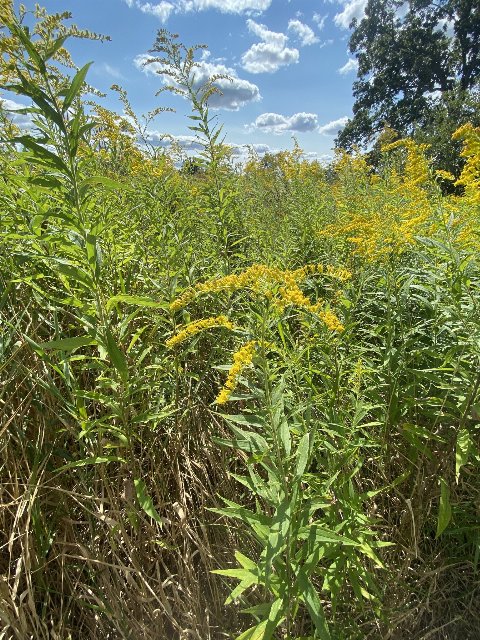 Tall goldenrod (Solidago altissima) is often a dominant component of the ecosystems where it occurs. It thus contributes both a high amount of total biomass and structure, to the ecosystem. Without large goldenrods, many ecosystems would be very different and much poorer as a result. Photo © botany08, CC BY 4.0, Source.
Tall goldenrod (Solidago altissima) is often a dominant component of the ecosystems where it occurs. It thus contributes both a high amount of total biomass and structure, to the ecosystem. Without large goldenrods, many ecosystems would be very different and much poorer as a result. Photo © botany08, CC BY 4.0, Source.Even "smaller" goldenrods are often robust relative to the ecosystems they occur in. For example, sweet goldenrod (Solidago odora) is often one of the larger perennials in the acidic, nutrient-poor soils it grows in.
The large biomass of these species amplifies their benefit to the food web, such that they support not only diversity, but also large numbers of insects. The volume of insects then supports larger animals such as nesting birds. But the contributions to the food web are only one among many ecosystem services provided by goldenrods.
The physical robustness of goldenrods, especially the taller species, makes them valuable as cover for animals, and structure that other plants can use for support, not just including small vines but also other, floppier herbaceous plants that cannot support their own weight. The dense structure also reduces wind speeds and moderates temperature and humidity at lower levels in a thicket of plants.
The below-ground biomass, including the aggressive and extensive root systems of large colonies of goldenrods, also plays a key role in soil health. The aggressive roots help to stabilize soil and prevent erosion. The feeding of insects on roots creates burrowing action that aerates soil and cycles nutrients down to lower layers of soil. This process plays a key role in improving the soil structure and ultimately paving the way for succession to larger trees on some sites, such as when Solidago altissima colonizes sites with rich but compacted soil.
By investing so much energy in below-ground growth, goldenrods help make ecosystems resilient in the face of disturbances. When above-ground vegetation is cleared, such as by fire, flooding, deposition of sediment, heavy browsing by large mammalian herbivores, or anthropogenic disturbances such as mowing or weedwhacking, goldenrods just resprout, often after sending their rhizomes and/or stems into new locations to reconfigure in response to shifting ground. Goldenrods are critical for quickly revegetating disturbed sites, covering the ground with new foliage, and thus both reducing erosion, and moderating the ground-level temperature swings that often follow any disturbance that exposes the ground to sunlight. In the regions in which they are native, goldenrods can be seen as part of nature's healing mechanisms following a disturbance.
Maintenance of Open Habitats
Especially in the more humid parts of North America, such as the east and northwest, goldenrods play a key role in keeping open habitats open. Most of eastern North America has rich enough soil and high enough rainfall to support closed-canopy forests in the absence of disturbance that kills or removes trees. Following European colonization of North America, fire suppression, both intentional and unintentional (such as through building roads, which act as firebreaks) has led to the reduction of open habitats in areas of the east where land is left wild. A disproportionate number of open habitats are now managed, such as mowed lawn or cropland, not open habitat such as meadows, prairies, or savannas.Most goldenrods tend to grow on open sites such as meadows and prairies. But the relationship between goldenrods and open habitats is not merely one-directional: some goldenrods, including tall and Canada goldenrod, are allelopathic, meaning that they produce chemicals that inhibit the growth of other plants. This process delays, but cannot fully prevent, the colonization of open sites by trees. In slowing the growth of woody plants, these goldenrods protect open habitats, causing them to persist longer even in the absence of fire.
Resistance to Invasive Species
The combination of allelopathy and general robustness makes goldenrods a good buffer against a newer threat to ecosystems: invasive plants, plants that have been introduced across a major geographic divide, and threaten to disrupt ecosystems, often because native herbivores are not adapted to eat them. An invasive plant is generally going to have a much tougher time invading a habitat with goldenrods than one without.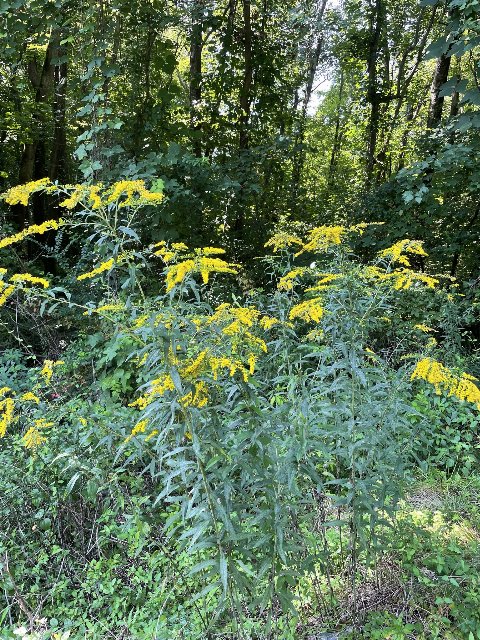 This colony of giant goldenrod (Solidago gigantea) under a power line clearance in Wadesboro, NC is competing successfully with numerous invasives, including Japanese honeysuckle (Lonicera japonica) and kudzu (Pueraria montana), two of the most aggressive ones. Plants like this both compete for light, and compete in the rootspace for water and nutrients. Photo © Becky Dill, Public Domain, Source.
This colony of giant goldenrod (Solidago gigantea) under a power line clearance in Wadesboro, NC is competing successfully with numerous invasives, including Japanese honeysuckle (Lonicera japonica) and kudzu (Pueraria montana), two of the most aggressive ones. Plants like this both compete for light, and compete in the rootspace for water and nutrients. Photo © Becky Dill, Public Domain, Source.I have also seen goldenrods competing, sometimes successfully, against some of the worst invasives, such as giant goldenrod pushing up through a patch of the Eurasian common reed (Phragmites australis), or tall goldenrod holding its own against common mugwort (Artemisia vulgaris). Sometimes goldenrods can even compete against invasives in unexpected, novel anthropogenic habitats, such as seaside goldenrod (Solidago sempervirens) seeding into patches of giant foxtail (Setaria faberi) in sandy and gravely soil along a railroad track.
The insects supported by goldenrods can also indirectly protect against invasion by other invasive insects. The insect community supported by goldenrods includes numerous generalist predators, such as praying mantises, spiders, and all manners of predatory bugs and beetles. Goldenrods also directly support larger animals, especially birds, which not only feed on the insect food but also directly on goldenrod seeds. Many of these predators will happily devour a random new insect that comes their way, thus making a habitat with goldenrods a lot more hostile towards a potential invasive insect.
Wrongly Blamed As Allergens
In the past, goldenrod was blamed for allergies, particularly seasonal "hay fever" which tends to strike in late summer into early fall, around when most goldenrods bloom. However, goldenrods are insect-pollinated and thus have heavy, sticky pollen that tends not to become airborne and people tend not to breathe in. Even people who react to goldenrod on a histamine allergy test will typically not experience many allergy symptoms caused by these flowers.The true culprit in "goldenrod" allergies are a close relative: ragweeds (Ambrosia sp.), which often grow together with goldenrods. Common ragweed (Ambrosia artemisiifolia) often grows together with tall goldenrod (Solidago altissima) in sunny, slightly dry habitats, and giant ragweed (Ambrosia trifida) often grows with giant goldenrod (Solidago gigantea) in moist bottomlands. Ragweeds have light, wind-borne pollen, and allergies to them are common and often quite unpleasant. But because ragweed's flowers are wind-pollinated, they are not showy, and as such, when people walk through an area full of ragweed, they often notice the showy goldenrod flowers and not the ragweed, and wrongly associate their allergy symptoms with the goldenrod.
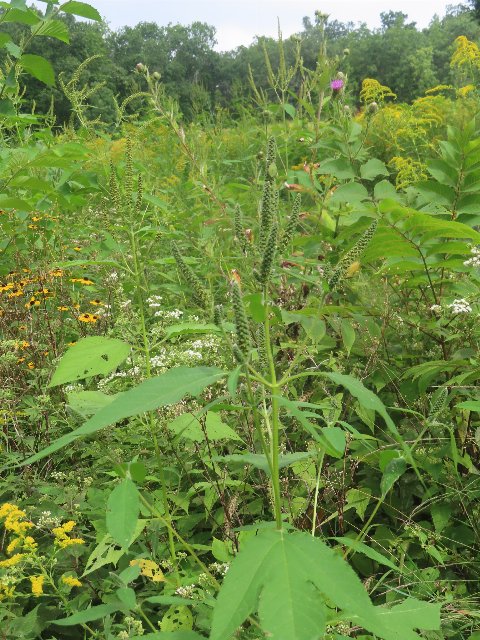 A typical sight in rich, moist bottomlands, giant ragweed (Ambrosia trifida) is growing together with giant goldenrod (Solidago gigantea) (lower-left and top-right corner). People may notice their allergies flare up when walking by such plant associations. Because the ragweed flowers (greenish conical structures) are easily overlooked, whereas the goldenrod flowers are visible and distinctive, many people form a mental association of goldenrods as causing their allergies. However, ragweed is usually the culprit. Photo © Eric Schmidt, CC BY 4.0, Source.
A typical sight in rich, moist bottomlands, giant ragweed (Ambrosia trifida) is growing together with giant goldenrod (Solidago gigantea) (lower-left and top-right corner). People may notice their allergies flare up when walking by such plant associations. Because the ragweed flowers (greenish conical structures) are easily overlooked, whereas the goldenrod flowers are visible and distinctive, many people form a mental association of goldenrods as causing their allergies. However, ragweed is usually the culprit. Photo © Eric Schmidt, CC BY 4.0, Source.A side note is that this pattern plays out in general: pollen allergies tend to be caused by tall, wind-pollinated plants, which tend to have less-showy flowers. Such plants include trees such as oak or mulberry, and various conifers, but not showy flowering trees such as cherry or magnolia. Similarly, they include plants such as grasses and nettle-family plants. Some genera of wind-pollinated plants, such as pellitory (Parietaria sp.) are important allergens globally, but the locally-native species, such as Pennsylvania pellitory (Parietaria pensylvanica), are so small that they rarely cause much trouble for people.
Utilizing Goldenrods
Goldenrods can be used both in gardening and landscaping, and in ecological restoration projects. The common complaint I hear about goldenrods is that they are "too aggressive" and "will take over your garden". While there is some truth in these remarks, at least for certain species, there are so many different goldenrods that there is almost always at least one or two species you can choose for a garden that will grow well, but without taking over or creating a problem.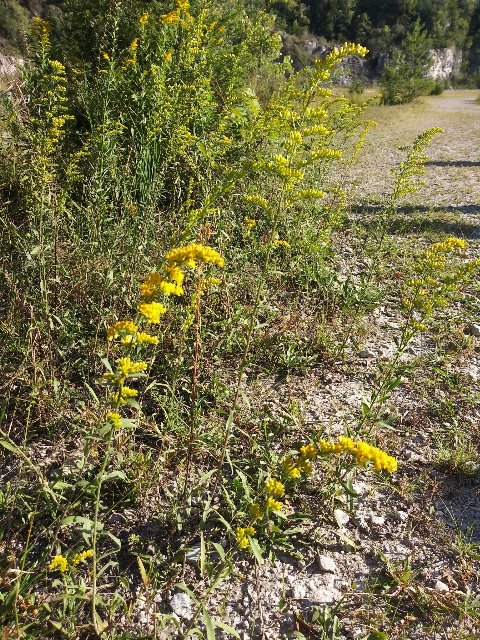 Many gardeners object to goldenrods as being too large and aggressive, but there are numerous goldenrods adapted to drier, harsher habitats that are smaller in size and less aggressive. Pictured here is gray goldenrod (Solidago nemoralis), a delicate plant that does not overwhelm other vegetation, and usually only grows where the soil is too dry and nutrient-poor for there to be much competition. Photo © Martyn Drabik-Hamshare, Public Domain, Source.
Many gardeners object to goldenrods as being too large and aggressive, but there are numerous goldenrods adapted to drier, harsher habitats that are smaller in size and less aggressive. Pictured here is gray goldenrod (Solidago nemoralis), a delicate plant that does not overwhelm other vegetation, and usually only grows where the soil is too dry and nutrient-poor for there to be much competition. Photo © Martyn Drabik-Hamshare, Public Domain, Source.Some of the goldenrods that prefer drier habitats with poorer soils make a better choice for gardens. One such example would be early goldenrod (Solidago juncea), and an example favoring even drier sites would be gray goldenrod (Solidago nemoralis). These species tend to grow slower and reach a smaller maximum size, and their greater drought tolerance can make them look good even in a dry year without watering. Their lower nutrient needs can eliminate the need for fertilizing. They make excellent choices for a bed where you add sand or gravel instead of mulch. They also can be a great choice for urban areas where the conditions are difficult due to reflected heat from pavement and buildings.
Even the more aggressive goldenrods can sometimes be utilized effectively in gardens. Tall and Canada goldenrods are showy, mindlessly easy to grow, and tend to shut out most competition, reducing the need for weeding. Giant goldenrod can also be used effectively in gardens when there is a bed that slopes down into a low, wet area in the back; in this scenario the giant goldenrod will thrive in the low area, pushing up through other plants, but will usually not move up into the drier part of the bed.
Where goldenrods usually shine the most, however, is in mass plantings in ecological restoration work. Giant goldenrod is ideal for riparian restorations, plantings to control erosion along streambanks and in floodplains. Tall goldenrod can be planted along roadsides and sunny edge habitats where soil is nutrient-rich but may be compacted or disturbed. Seaside goldenrod can even be useful for reclamation of former industrial sites, where it tolerates thin soils as well as the presence of salt and some minerals that would kill other plants. It also can thrive in roadside plantings due to its tolerance of drought and road salt.
Identification as Key to Understanding
The best way to understand plants and their habitat needs and ecological relationships is to observe them yourself, in the wild, in areas around you. To this end, it is helpful to know what you are looking at. As such we have prioritized completing ID guides, in many cases before we even complete the articles on each plant.We invite you to check out our currently completed ID guides on the Solidago genus, and to stay tuned for the completion of more guides.
Completed Solidago ID Guides
| Guide | Date Started↓ | Date Updated |
| Blue-Stemmed Goldenrod (Solidago caesia) vs. Mountain Decumbent Goldenrod (Solidago curtisii) | Mar 06, 2025 | Jul 20, 2025 |
| Tall Goldenrod (Solidago altissima) vs. Sweet Goldenrod (Solidago odora) | Mar 06, 2025 | Jul 20, 2025 |
| Early Goldenrod (Solidago juncea) vs. Sweet Goldenrod (Solidago odora) | Mar 05, 2025 | Jul 20, 2025 |
| Canada Goldenrod (Solidago canadensis) vs. Giant Goldenrod (Solidago gigantea) | Jan 16, 2025 | Jan 17, 2025 |
| Giant Goldenrod (Solidago gigantea) vs. Early Goldenrod (Solidago juncea) | Jan 12, 2025 | Feb 07, 2025 |
| Tall Goldenrod (Solidago altissima) vs. Giant Goldenrod (Solidago gigantea) | Dec 04, 2024 | Feb 08, 2025 |
| Tall Goldenrod (Solidago altissima) vs. Canada Goldenrod (Solidago canadensis) | Jul 20, 2023 | Feb 15, 2025 |
Under Construction Solidago ID Guides
| Guide | Date Started↓ | Date Updated |
| Early Goldenrod (Solidago juncea) vs. Gray Goldenrod (Solidago nemoralis) | Feb 27, 2025 | Feb 27, 2025 |
| Canada Goldenrod (Solidago canadensis) vs. Wrinkleleaf Goldenrod (Solidago rugosa) | Feb 05, 2025 | Feb 05, 2025 |
| Tall Goldenrod (Solidago altissima) vs. Wrinkleleaf Goldenrod (Solidago rugosa) | Jan 23, 2025 | Jan 28, 2025 |
| Blue-Stemmed Goldenrod (Solidago caesia) vs. Elmleaf Goldenrod (Solidago ulmifolia) | Jan 12, 2025 | Jan 12, 2025 |
| Wrinkleleaf Goldenrod (Solidago rugosa) vs. Elmleaf Goldenrod (Solidago ulmifolia) | Jan 12, 2025 | Jan 31, 2025 |
Thank you for your support!
We want to thank all our donors for supporting our ongoing work on this and all our other projects, such as the plant and ecoregion articles and maps. bplant.org remains a mostly-volunteer effort that currently provides only minimal compensation to me, and we donate a modest amount to iNaturalist which we use as the primary source for open-licensed images that make these ID guides possible. You can read more details on our finances page which is always accessible in the footer. Anyone wishing to donate can use the link in the header or footer, or you can get in touch with us about other ways to contribute.Archive of All Blogs
The Bias Against Tall Plants, November 11th, 2025
A Focus on Goldenrods (Solidago sp.), July 23rd, 2025
Disturbance and its Role in Plant Habitat Preferences, May 29th, 2025
What "Native" or "Introduced" Mean: Myths and Misconceptions, March 11th, 2025
Smarter & More Informative Search Results, January 13th, 2025
The Effect of the 2024 US Election on Plant Biodiversity and bplant.org, October 30th, 2024
The Problems With Nursery-Bought Plants, And The Solutions, October 8th, 2024
More Databases Linked & Search Improvements for Scientific Names, July 9th, 2024
Choosing The Best Common Names For Plants: Challenges & Solutions, April 19th, 2024
Range Map & Taxonomic Update Progress, January 31st, 2024
Giving Thanks To Everyone We Rely On, November 22nd, 2023
Thinking More Deeply About Habitat, April 5th, 2023
2022 Year-End Summary: Successes & New Goals, February 15th, 2023
New Databases Linked: Flora of North America & NatureServe Explorer, November 11th, 2022
All Range Maps 2nd Generation, Taxonomic Updates, & Fundraising Goal Met!, September 29th, 2022
More Range Map Improvements, POWO Interlinking, And Notes Fields, June 7th, 2022
Ecoregion-Based Plant Lists and Search, March 30th, 2022
Progress Updates on Range Maps and More, February 10th, 2022
The Vision for bplant.org, December 9th, 2021
New Server: Software & Hardware, August 30th, 2021
More & Improved Plant Range Maps, July 19th, 2021
A Control Section for Invasive Plants, April 15th, 2021
Progress Bars & State Ecoregion Legends, March 11th, 2021
Our 2020 Achievements, February 9th, 2021
Interlinking Databases for Plant Research, November 11th, 2020
A New Homepage, Highlighting Our Articles, July 29th, 2020
A False Recovery, But North Carolina's Ecoregions are Complete!, June 9th, 2020
We're Back After COVID-19 Setbacks, April 3rd, 2020
Help Us Find Ecoregion Photos, February 27th, 2020
What We Achieved in 2019, December 30th, 2019
Plant Comparison and ID Guides, October 30th, 2019
We Are Now Accepting Donations, October 14th, 2019
US State Ecoregion Maps, New Footer, Ecoregion Article Progress, and References, September 19th, 2019
Tentative Range Maps of Native Plants, August 12th, 2019
Ecoregion Locator and Interactive Maps, July 10th, 2019
Using Ecoregions Over Political Boundaries, May 13th, 2019
How We Handle Wild vs Cultivated Plants, April 16th, 2019
A Blog To Keep People Updated On Our Progress, April 8th, 2019
Sign Up
Want to get notified of our progress? Sign up for the bplant.org interest list!

